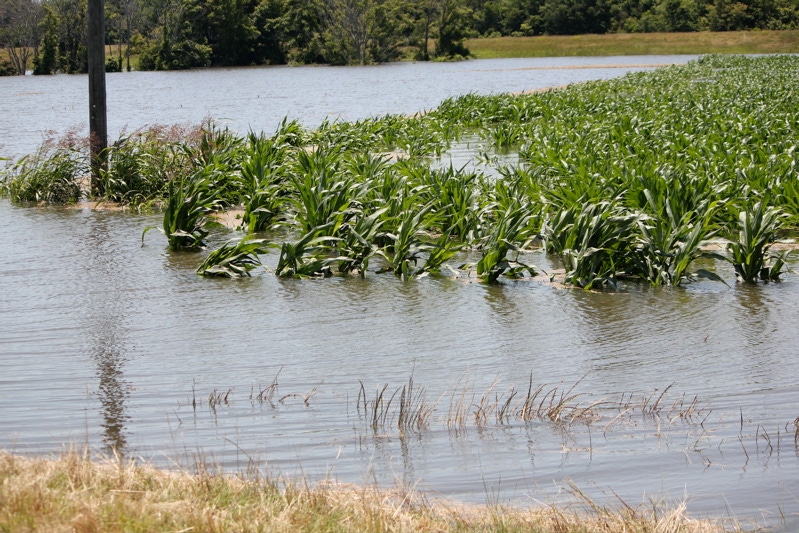
Glyphosate-resistant weeds have been a major, growing problem in the Mid-South for years. Could the recent flooding actually exacerbate the situation?
Unfortunately, the answer is yes. With historic flooding weed seed has had a wide, easy avenue to travel South on.
“I’ve been thinking about this and how many seed are floating in all this water,” says Ken Smith, Arkansas Extension weed specialist. “We know pigweed seed will float and move -- actually, not only pigweed but many weeds.
“And we’re getting a lot of water moving south from the Midwest. There are serious problems with resistant waterhemp in that region. And waterhemp and other species are coming right down the Mississippi – and not inside the banks.
“Yes, we will be seeing a lot of new biotypes and species in the Mid-South. It will certainly contribute to our problems. Unfortunately, I think things may be about to change for growers down in Louisiana who haven’t had resistant Palmer before. For sure, we’re sending them plenty of seed.”
For more, see Waterhemp next glyphosate-resistant weed.
It isn’t a coincidence that “our first discovery of resistant Palmer was next to the Mississippi River. The first confirmation of resistant Johnson grass was right on the Mississippi River. And those spread right up the White River.
The early confirmation of herbicide-resistant weeds seems to follow those rivers. And “the worst problems with these weeds are now along the waterways. The current flood will redistribute the problems and leave them in a lot more fields.”
Asked about expectation for weed control once floodwaters recede, Smith says much depends on how quickly farmers can get back into their fields. “If the water stays on a field for a while, the ground will be really clean.”
For many, that could be false security.
“That’s because within all that silt, soil and debris that’s left behind there can be a lot of surprises. A farmer may think ‘I know that field and how it works.’ Well, after the flood, that field will have changed. And that includes a good possibility of a change in weed species.”
Recently, while walking through a newly-drained field, a farmer called Smith. “We were talking and suddenly he said ‘Oh, my goodness, there’s a crosstie just laying here.’ I said ‘Man, we don’t have a herbicide for crossties,’” says Smith, chuckling.
“The point is, there will be a lot of unexpected things left in these flooded fields. Weed seed that has floated in will definitely be a part of that.”
As the growing season progresses, “’vigilance’ will be the key word,” says Smith. “There’s no way to predict what species will emerge. But farmers need to keep an eye out for some that look different.”
Resistant waterhemp, a cousin to the now infamous Palmer amaranth, is the weed “that really concerns me. Waterhemp isn’t as prolific as Palmer, but it’s still prolific and the seed do float.”
In many locations, the flooding has delayed Smith and colleagues’ research this year. But job-wise, “the major difference for this time of year has been the number and different types of phone calls we’ve been getting. In the past, if you got 50 calls in May, 30 would be about nearly the same thing: ‘My crop is at this-or-that stage and here’s what I’m wondering about.’ Some days, I’ve thought ‘I could just record something on my answering machine that would take care of most of the calls coming in.’
“Well, that’s not what is going on this season. Every call is vastly different.”
Before the flooding began, what was Smith seeing regarding growers’ approach to resistant weeds?
“I thought we’d turned the corner, that this was the year where farmers would be addressing this head-on. All the calls, all the conversations I had showed everyone on the same page.”
Then the floods hit and “threw a wrench into everything. Now, we’re just struggling to get some semblance of a crop. Everyone is grabbing for straws, trying to make various practices work. There are certainly fewer options available.”
What about producers who have been tackling resistant weeds for a while and are now flooded? Could they be back to Square One?
“They could be, at least to some extent. I don’t think they’ll be back to the same level of seed they had at one time. However, their fields are infested.
“And flooding is inevitable. Whether it’s 10 or 15 years from now, there will be another time when a river leads its banks. So, we’ll always have fields where weed seed is a bigger threat.”
Even so, Smith is optimistic. “Although those farmers may face re-infestation and new problems emerging, they’ll be ready. They’ll be much more prepared than they were the first time resistance showed up in their fields.”
About the Author(s)
You May Also Like




